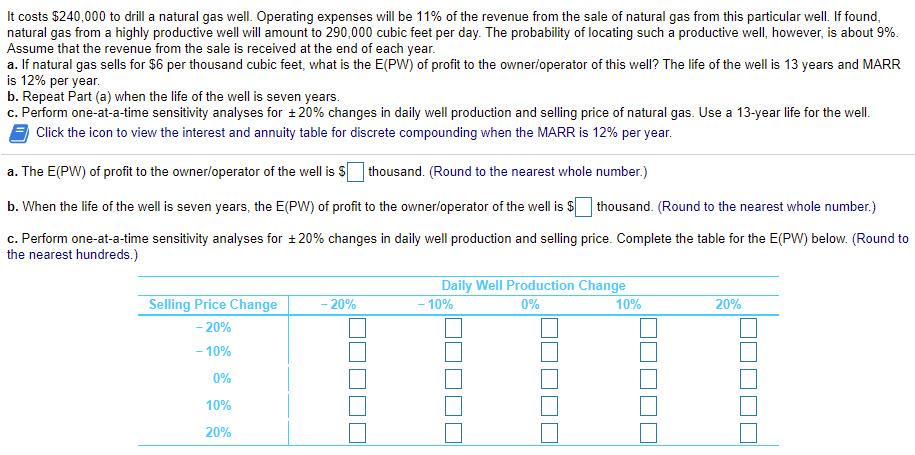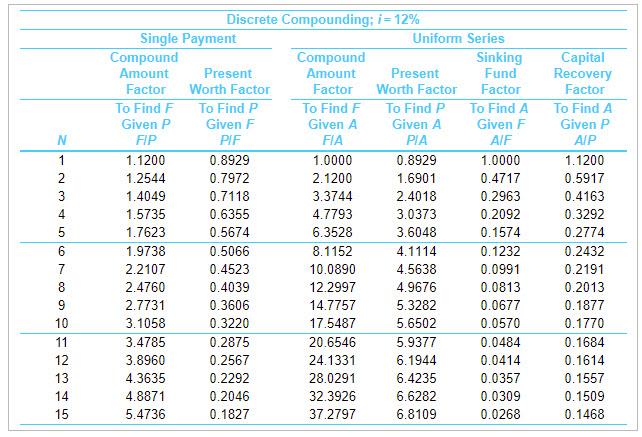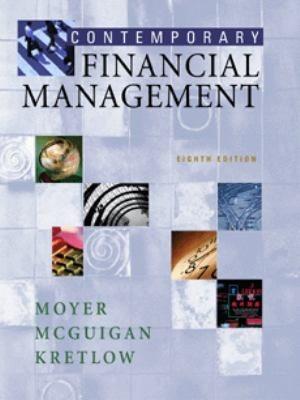

It costs $240,000 to drill a natural gas well. Operating expenses will be 11% of the revenue from the sale of natural gas from this particular well. If found, natural gas from a highly productive well will amount to 290,000 cubic feet per day. The probability of locating such a productive well, however, is about 9%. Assume that the revenue from the sale is received at the end of each year. a. If natural gas sells for $6 per thousand cubic feet, what is the E(PW) of profit to the owner/operator of this well? The life of the well is 13 years and MARR is 12% per year. b. Repeat Part (a) when the life of the well is seven years. c. Perform one-at-a-time sensitivity analyses for + 20% changes in daily well production and selling price of natural gas. Use a 13-year life for the well. Click the icon to view the interest and annuity table for discrete compounding when the MARR is 12% per year. a. The E(PW) of profit to the owner/operator of the well is thousand (Round to the nearest whole number.) b. When the life of the well is seven years, the E(PW) of profit to the owner/operator of the well is $thousand. (Round to the nearest whole number.) c. Perform one-at-a-time sensitivity analyses for + 20% changes in daily well production and selling price. Complete the table for the E(PW) below. (Round to the nearest hundreds.) Daily Well Production Change Selling Price Change - 20% - 10% 0% 10% 20% -20% - 10% 0% 10% 20% N 1 2 3 4 5 6 7 8 9 10 11 12 13 14 15 Discrete Compounding; i=12% Single Payment Uniform Series Compound Compound Sinking Amount Present Amount Present Fund Factor Worth Factor Factor Worth Factor Factor To Find F To Find P To Find F To Find P To Find A Given P Given F Given A Given A Given F FIP PIF FIA PIA AIF 1.1200 0.8929 1.0000 0.8929 1.0000 1.2544 0.7972 2.1200 1.6901 0.4717 1.4049 0.7118 3.3744 2.4018 0.2963 1.5735 0.6355 4.7793 3.0373 0.2092 1.7623 0.5674 6.3528 3.6048 0.1574 1.9738 0.5066 8.1152 4.1114 0.1232 2.2107 0.4523 10.0890 4.5638 0.0991 2.4760 0.4039 12.2997 4.9676 0.0813 2.7731 0.3606 14.7757 5.3282 0.0677 3.1058 0.3220 17.5487 5.6502 0.0570 3.4785 0.2875 20.6546 5.9377 0.0484 3.8960 0.2567 24.1331 6.1944 0.0414 4.3635 0.2292 28.0291 6.4235 0.0357 4.8871 0.2046 32.3926 6.6282 0.0309 5.4736 0.1827 37.2797 6.8109 0.0268 Capital Recovery Factor To Find A Given P AIP . 1.1200 0.5917 0.4163 0.3292 0.2774 0.2432 0.2191 0.2013 0.1877 0.1770 0.1684 0.1614 0.1557 0.1509 0.1468 It costs $240,000 to drill a natural gas well. Operating expenses will be 11% of the revenue from the sale of natural gas from this particular well. If found, natural gas from a highly productive well will amount to 290,000 cubic feet per day. The probability of locating such a productive well, however, is about 9%. Assume that the revenue from the sale is received at the end of each year. a. If natural gas sells for $6 per thousand cubic feet, what is the E(PW) of profit to the owner/operator of this well? The life of the well is 13 years and MARR is 12% per year. b. Repeat Part (a) when the life of the well is seven years. c. Perform one-at-a-time sensitivity analyses for + 20% changes in daily well production and selling price of natural gas. Use a 13-year life for the well. Click the icon to view the interest and annuity table for discrete compounding when the MARR is 12% per year. a. The E(PW) of profit to the owner/operator of the well is thousand (Round to the nearest whole number.) b. When the life of the well is seven years, the E(PW) of profit to the owner/operator of the well is $thousand. (Round to the nearest whole number.) c. Perform one-at-a-time sensitivity analyses for + 20% changes in daily well production and selling price. Complete the table for the E(PW) below. (Round to the nearest hundreds.) Daily Well Production Change Selling Price Change - 20% - 10% 0% 10% 20% -20% - 10% 0% 10% 20% N 1 2 3 4 5 6 7 8 9 10 11 12 13 14 15 Discrete Compounding; i=12% Single Payment Uniform Series Compound Compound Sinking Amount Present Amount Present Fund Factor Worth Factor Factor Worth Factor Factor To Find F To Find P To Find F To Find P To Find A Given P Given F Given A Given A Given F FIP PIF FIA PIA AIF 1.1200 0.8929 1.0000 0.8929 1.0000 1.2544 0.7972 2.1200 1.6901 0.4717 1.4049 0.7118 3.3744 2.4018 0.2963 1.5735 0.6355 4.7793 3.0373 0.2092 1.7623 0.5674 6.3528 3.6048 0.1574 1.9738 0.5066 8.1152 4.1114 0.1232 2.2107 0.4523 10.0890 4.5638 0.0991 2.4760 0.4039 12.2997 4.9676 0.0813 2.7731 0.3606 14.7757 5.3282 0.0677 3.1058 0.3220 17.5487 5.6502 0.0570 3.4785 0.2875 20.6546 5.9377 0.0484 3.8960 0.2567 24.1331 6.1944 0.0414 4.3635 0.2292 28.0291 6.4235 0.0357 4.8871 0.2046 32.3926 6.6282 0.0309 5.4736 0.1827 37.2797 6.8109 0.0268 Capital Recovery Factor To Find A Given P AIP . 1.1200 0.5917 0.4163 0.3292 0.2774 0.2432 0.2191 0.2013 0.1877 0.1770 0.1684 0.1614 0.1557 0.1509 0.1468








